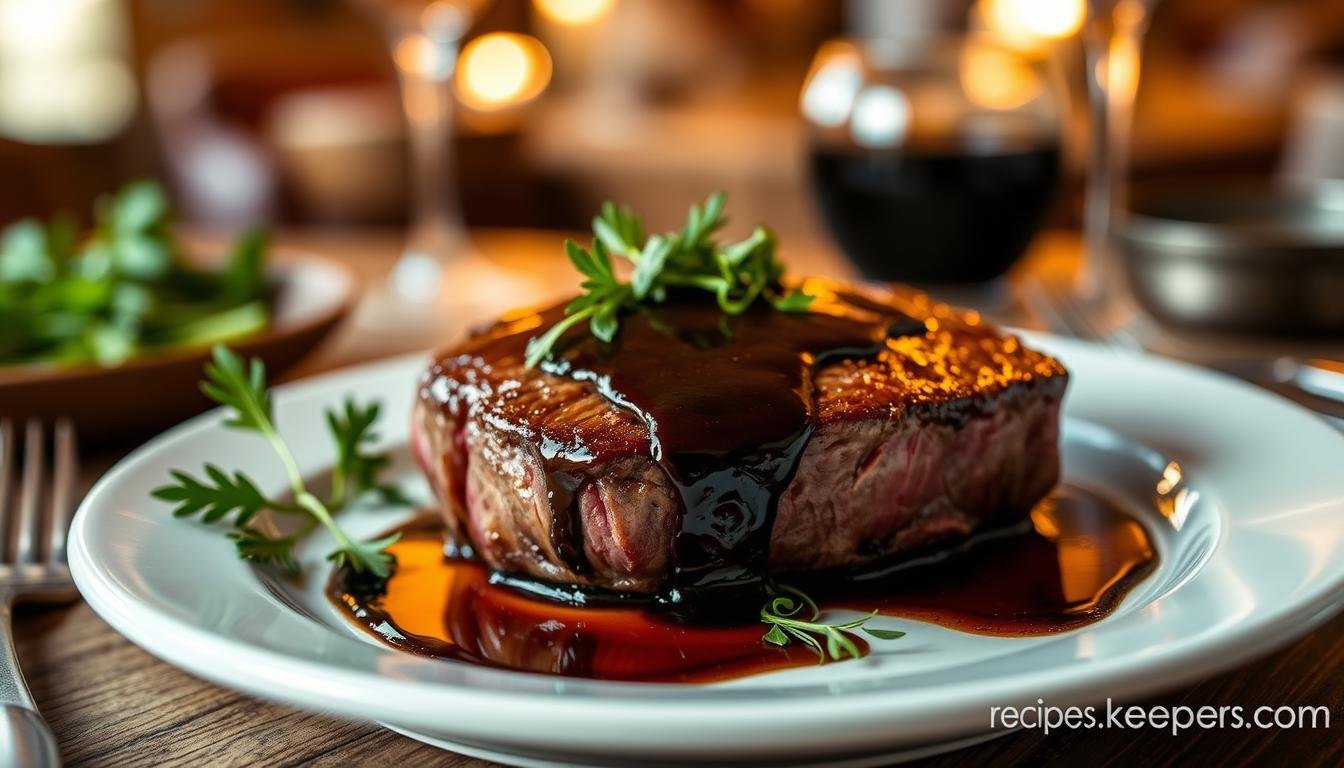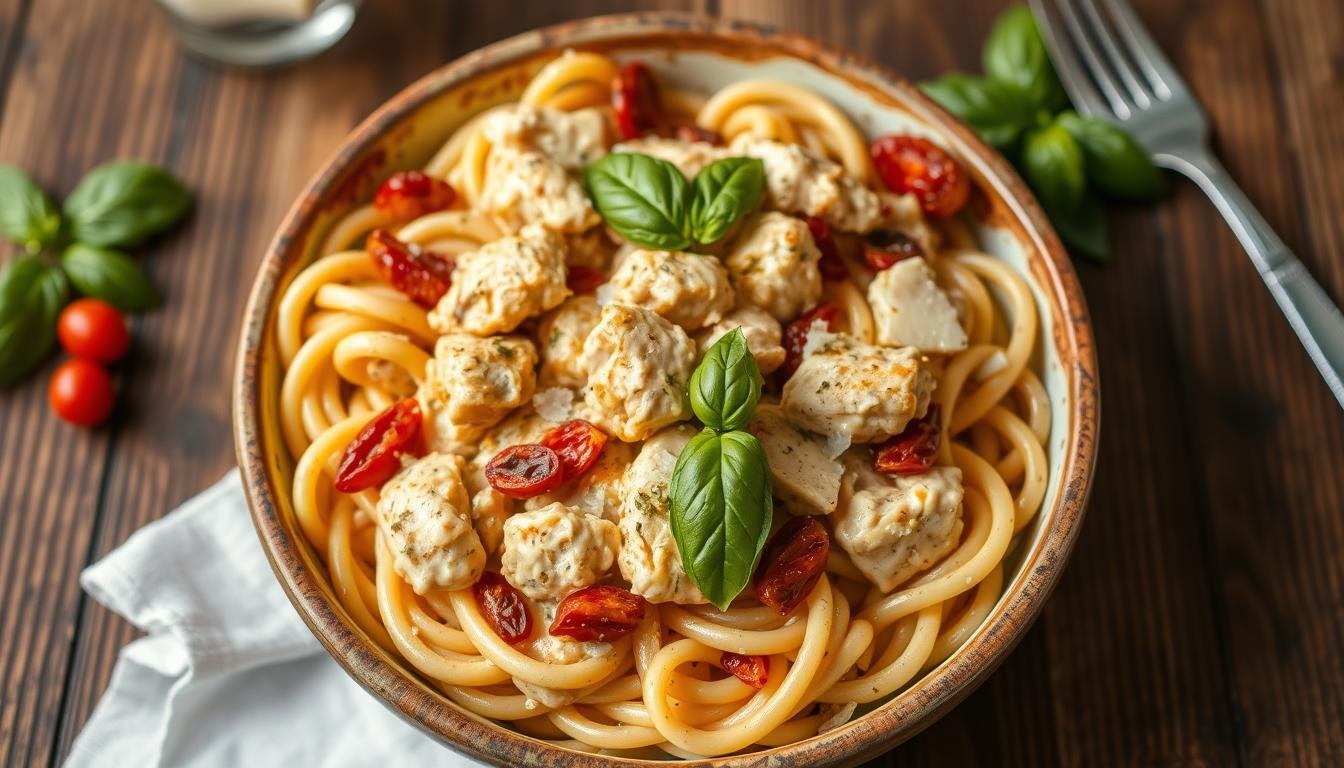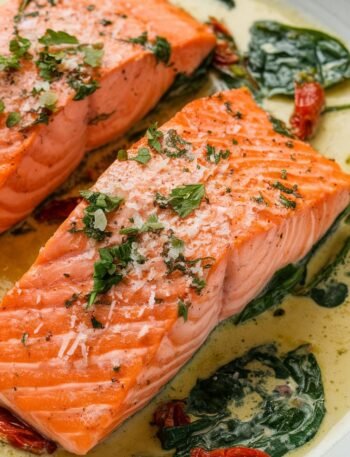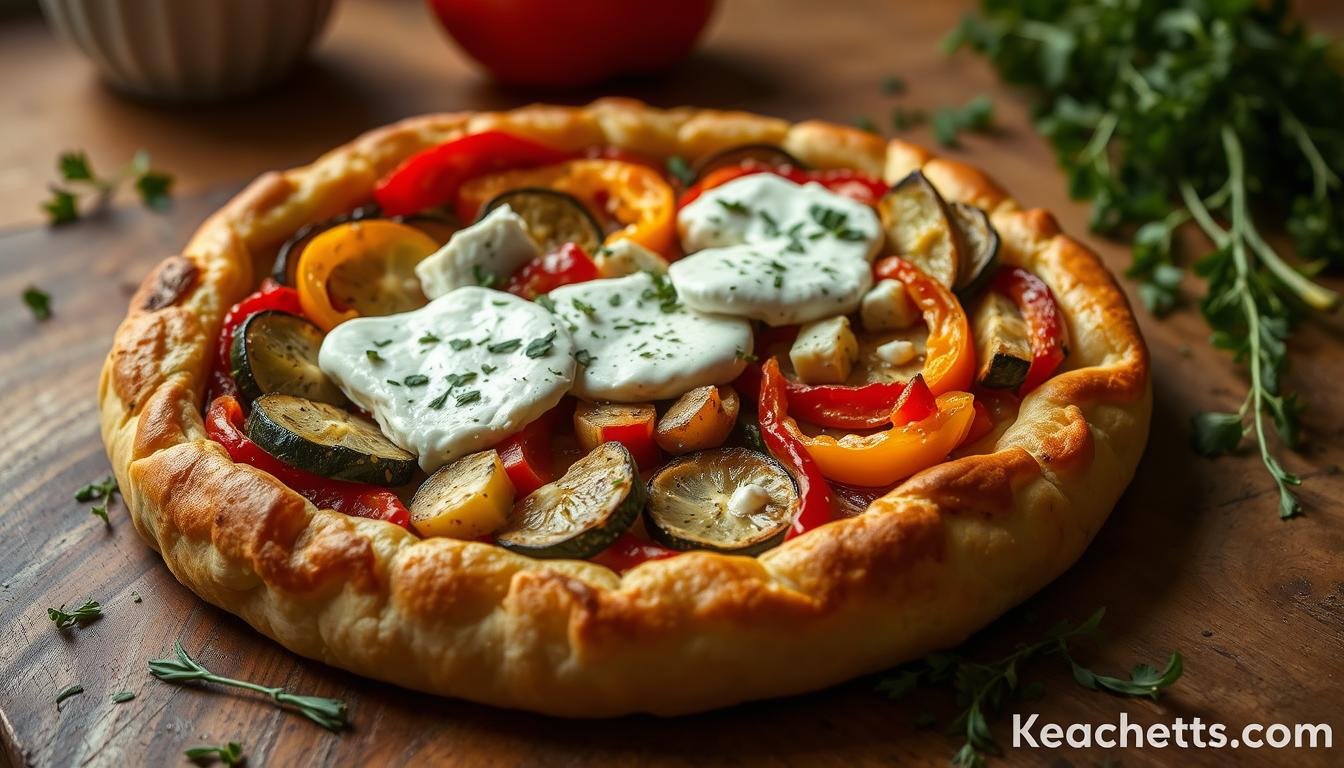Welcome to Recipe Keepers! Today, we’re making a simple evening into a fancy dinner with our beef tenderloin recipe. You’ll learn how to make a filet mignon that’s as good as in a restaurant. It comes with a delicious balsamic glaze that will wow everyone.
Cooking the perfect steak is an art. We’ll show you how to make a filet mignon that tastes like it’s from a fancy restaurant. This recipe is perfect for any special occasion or just a great meal for yourself.
Key Takeaways
- Learn to cook restaurant-quality filet mignon at home
- Master the perfect balsamic glaze technique
- Discover professional steak cooking tips
- Create a gourmet meal in under an hour
- Understand precise cooking temperatures for ideal doneness
Introduction to Gourmet Steak Preparation
Preparing a restaurant-quality filet mignon at home might seem tough. But with the right techniques, anyone can make a fine dining experience at home. This tender beef is the top choice for fine dining, making any meal special.
Understanding filet mignon means knowing its special traits. It comes from the tenderloin, known for being very soft and having a mild taste. Chefs and home cooks love it for making any meal better.
Key Preparation Insights
- Choose high-quality grass-fed beef for optimal taste
- Understand proper temperature control
- Master precise cooking techniques
- Select complementary seasonings
| Preparation Aspect | Recommended Detail |
|---|---|
| Steak Thickness | 1.5 inches recommended |
| Preparation Time | 30 minutes total |
| Serving Size | 4 servings |
| Ideal Internal Temperature | 130-135°F for medium-rare |
Our guide will show you how to turn simple meat into a gourmet dish. We’ll teach you professional techniques for cooking the perfect filet mignon. This way, you can make restaurant-quality meals at home.
Essential Ingredients for the Perfect Filet Mignon
Creating an elegant entrée starts with selecting the highest quality ingredients. The magic of a perfect filet mignon lies in the careful selection of each component. This includes the meat and the balsamic vinegar reduction that will elevate your dish.
Premium Quality Meat Selection
Your filet mignon is the star of the show. When choosing your steaks, look for these key characteristics:
- Deep red color with minimal discoloration
- Thickness of approximately 1 inch
- Weight of 4-6 ounces per steak
- Minimal marbling for a lean cut
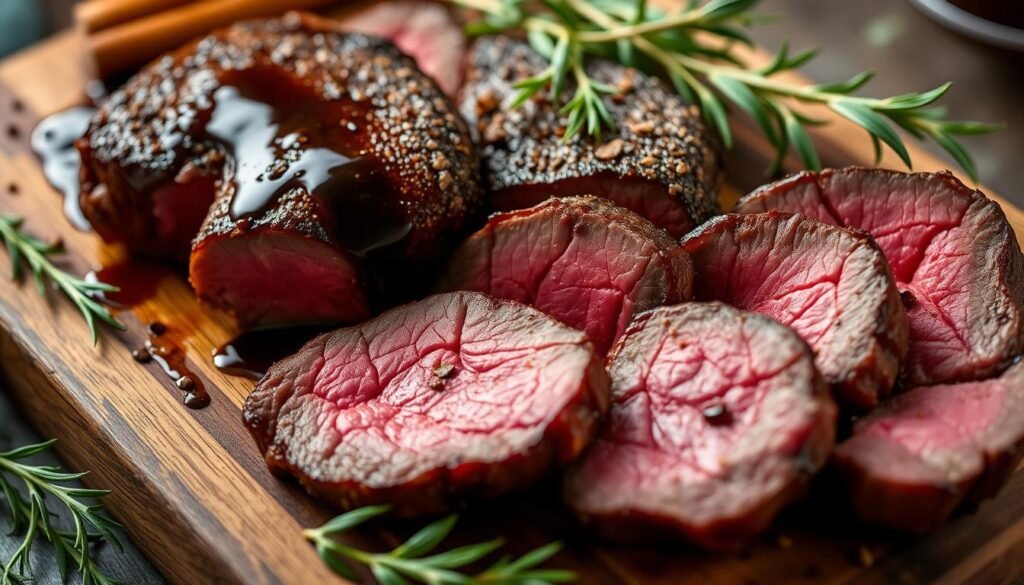
Balsamic Glaze Components
The balsamic vinegar reduction transforms an ordinary steak into a culinary masterpiece. Here’s what you’ll need:
| Ingredient | Quantity |
|---|---|
| Balsamic Vinegar | ½ cup |
| Dry Red Wine | ½ cup |
| Brown Sugar | 1 tablespoon |
Additional Seasoning Requirements
Simple seasonings can dramatically enhance your filet mignon’s flavor profile:
- Kosher Salt: 1 teaspoon
- Fresh Ground Black Pepper: ½ teaspoon
- Olive Oil: 2 tablespoons
- Optional: Minced Garlic (1 clove)
- Optional: Fresh Rosemary Sprigs
Pro tip: Always bring your ingredients to room temperature before cooking. This ensures even heat distribution and optimal flavor development in your balsamic vinegar reduction and filet mignon.
The Science Behind Perfect Steak Temperature
Mastering steak temperature is key for a perfect fine dining experience at home. Knowing the science behind cooking temperatures turns a simple steak into a culinary masterpiece. Professional chefs stress the importance of precision in cooking a delicious steak.
The journey of a steak’s temperature is quite interesting. Each level of doneness has its own internal temperature, creating unique flavors and textures. Let’s look at the temperature ranges for each level of steak doneness:
- Rare: 120-125°F – Bright red center, soft texture
- Medium-rare: 130-135°F – Warm red center, most recommended by steak enthusiasts
- Medium: 140-145°F – Pink center with some browning
- Medium-well: 150-155°F – Slight pink center
- Well-done: 160°F and above – No pink, fully cooked
The magic happens during carryover cooking, where the steak continues to rise in temperature after being removed from heat. This means you should pull your steak off the grill a bit before it reaches the target temperature. A meat thermometer is your best tool for precise doneness.
Professional chefs suggest a reverse sear method for thick cuts. This method creates a beautiful temperature gradient and ensures even cooking. Thicker steaks (1.5 inches or more) are best for this technique, offering a perfectly pink interior and a beautifully caramelized exterior.
Preparing Your Filet Mignon with Balsamic Glaze
Creating a fine dining experience starts with careful preparation. Our beef tenderloin needs attention to detail. This turns a simple meal into a memorable culinary journey.
Room Temperature Preparation
Professional chefs know the secret to a perfect steak. Take your filet mignon out of the fridge 45 minutes before cooking. This step ensures even cooking and tender meat.
- Remove steaks 45 minutes prior to cooking
- Place steaks on a clean kitchen surface
- Allow meat to reach room temperature naturally
Seasoning Techniques
Seasoning is an art in fine dining. For our beef tenderloin, we use a simple yet effective method to boost flavor.
- Pat steaks completely dry with paper towels
- Use 1/2 teaspoon kosher salt per steak
- Apply 1/2 teaspoon freshly ground black pepper
- Season both sides generously
Pre-cooking Steps
Before cooking, a few steps can make your filet mignon amazing. Make sure your pan is hot and your ingredients are ready for a smooth cooking process.
- Gather all ingredients beforehand
- Prepare a cast-iron skillet or heavy-bottomed pan
- Have 1/2 tablespoon vegetable oil ready
- Check that steak surfaces are completely dry
Mastering the Pan-Searing Technique
Pan-searing is a key skill for chefs in gourmet dining. It turns a simple steak into a dish fit for a restaurant. The steak gets a crispy outside and stays tender inside.
For pan-searing success, you need:
- A heavy-bottomed cast iron skillet
- A very hot pan before adding the steak
- The right cooking oil with a high smoke point
- Perfect timing for the sear
Getting the pan-searing right takes focus on temperature and timing. For a great filet mignon, follow these steps:
- Take the steak out of the fridge 30 minutes before cooking
- Pat the steak dry with paper towels
- Season it well with coarse sea salt and black pepper
- Heat the skillet over medium-high heat
- Add oil with a high smoke point
The searing time depends on the steak’s thickness. But usually, it’s 2-4 minutes per side. This method helps create a golden-brown crust that keeps the steak’s juices in.
| Steak Thickness | Searing Time per Side | Recommended Doneness |
|---|---|---|
| 1.5 inches | 2-3 minutes | Medium-Rare |
| 2 inches | 3-4 minutes | Medium |
Professional chefs stress the importance of patience in pan-searing. Don’t keep moving or flipping the steak. Let it cook undisturbed to get that perfect crust.
Creating the Perfect Balsamic Wine Reduction
To make your Filet Mignon with Balsamic Glaze even better, learn to make a rich balsamic vinegar reduction. This sauce will take your dish from great to amazing, pleasing your taste buds.
Selecting the Right Wine
Picking the right wine is key for your balsamic wine reduction. Choose strong red wines that match the flavor of balsamic vinegar. Good choices are:
- Chianti
- Cabernet Sauvignon
- Merlot
Reduction Process Breakdown
Making a great balsamic vinegar reduction needs focus and patience. Follow these steps for the perfect glaze:
- Start with 1/2 cup of top-notch balsamic vinegar
- Add 1/2 cup of dry red wine
- Include 1 teaspoon of dark brown sugar
- Optional: Add a minced garlic clove for more flavor
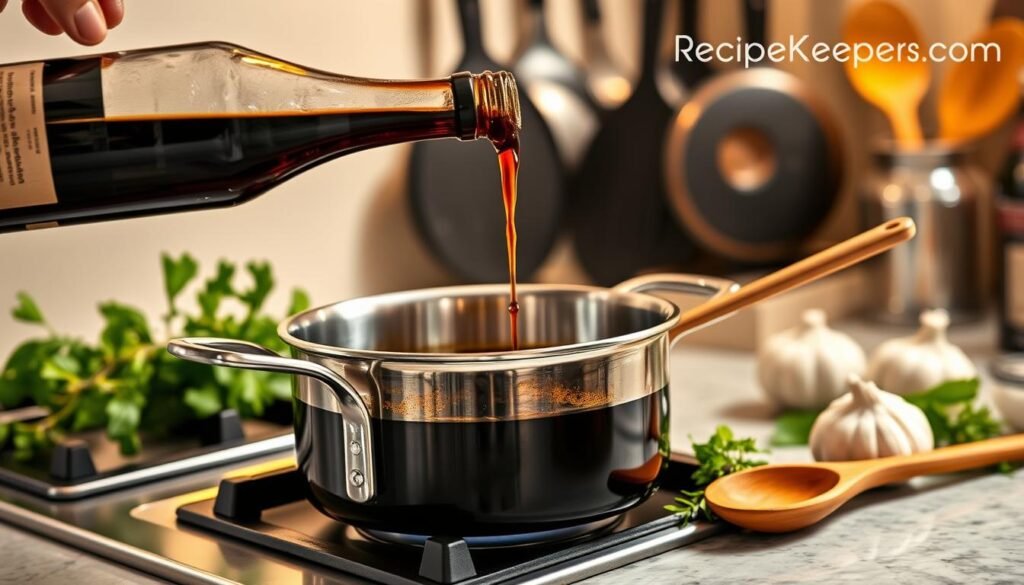
Achieving Ideal Consistency
The trick to a perfect balsamic vinegar reduction is in the simmering. Reduce the liquid by about two-thirds, which takes about 10 minutes. The glaze should stick to the back of a spoon and be syrupy. This will make your Filet Mignon with Balsamic Glaze even more special.
| Ingredient | Quantity | Purpose |
|---|---|---|
| Balsamic Vinegar | 1/2 cup | Base of reduction |
| Red Wine | 1/2 cup | Adds depth and complexity |
| Brown Sugar | 1 tsp | Balances acidity |
| Garlic (optional) | 1 clove | Enhances flavor profile |
With these tips, you’ll make a balsamic wine reduction that turns your steak into something truly special. Remember, patience, quality ingredients, and watching the reduction closely are the keys.
Precise Cooking Times and Temperatures
Mastering fine dining at home begins with knowing the right cooking temperatures for beef tenderloin. Achieving the perfect doneness requires focus on both time and heat.
Let’s explore the ideal cooking temperatures for filet mignon to bring a restaurant-quality meal to your kitchen. A professional chef’s secret is mastering these temperatures.
| Doneness Level | Temperature Range | Cooking Time |
|---|---|---|
| Rare | 120-128°F | 4-5 minutes |
| Medium-Rare | 129-134°F | 5-6 minutes |
| Medium | 135-144°F | 6-7 minutes |
| Medium-Well | 145-155°F | 7-8 minutes |
Here are some key tips for cooking the perfect beef tenderloin:
- Use a reliable meat thermometer
- Preheat your oven to 415°F
- Sear the steak before finishing in the oven
- Let the meat rest for 5-10 minutes after cooking
For the ultimate fine dining experience at home, aim for medium-rare at 130°F. This ensures a tender, juicy beef tenderloin that’s a delight to eat.
The Art of Resting Your Steak
In the world of gourmet dining, resting your steak is key. It turns a good meal into a top-notch experience. Many home cooks miss this important step, but pros know patience is essential for the perfect bite.
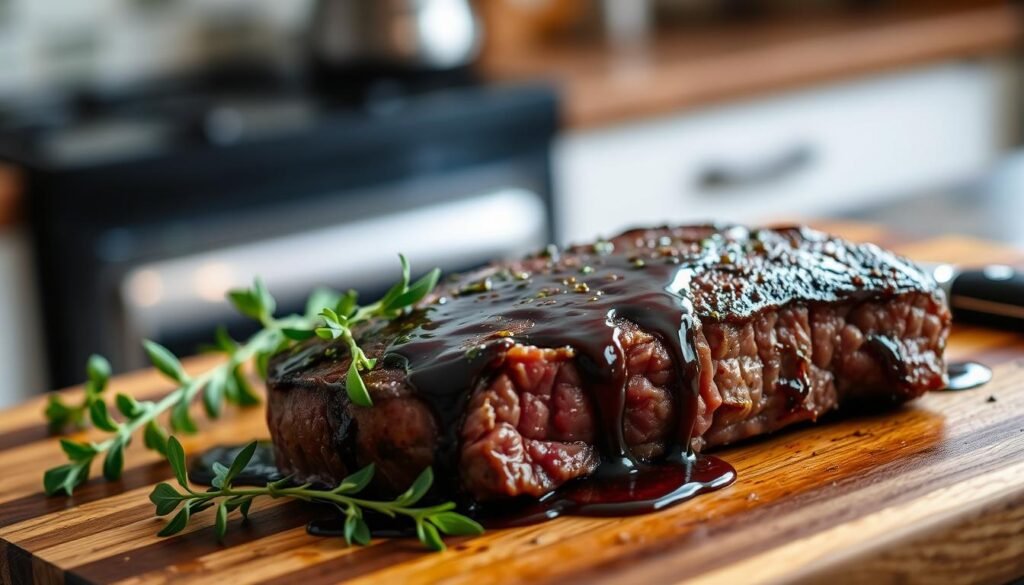
Why Resting Matters
Cooking a steak makes the meat’s fibers contract, pushing juices to the center. Resting lets these juices spread evenly, making each slice tender and full of flavor.
- Prevents juice loss when cutting
- Ensures even temperature distribution
- Enhances overall meat tenderness
Optimal Resting Duration
The right resting time varies with steak thickness. Here’s a quick guide for perfect results:
- Thin cuts (less than 1 inch): Rest for 3-5 minutes
- Medium cuts (1-2 inches): Rest for 5-7 minutes
- Thick cuts (over 2 inches): Rest for 10 minutes
Professional chefs suggest loosely covering your steak with foil during rest. This keeps the heat in and stops the meat from overcooking. For a typical filet mignon, a 5-10 minute rest will make your meal unforgettable.
Remember, in upscale cuisine, small details matter a lot. Your patience will pay off with a juicy, perfectly cooked steak that’s restaurant-quality.
Plating and Presentation Tips
Creating a stunning fine dining experience at home starts with how you plate. Your filet mignon is more than just a meal. It’s an elegant dish that deserves a presentation that wows both your eyes and taste buds.
Begin with a warm plate to keep your steak at the perfect temperature. Place your beautifully seared filet in the center. This lets you show off its rich, caramelized exterior.
Presentation Pro Tips:
- Drizzle balsamic glaze in an artistic, cascading pattern
- Add fresh herb garnishes for visual and aromatic appeal
- Utilize pan juices to create a flavorful “sauce moat” around the steak
- Choose white or neutral-colored plates to highlight the steak’s rich colors
Enhance your plating with simple yet elegant touches. A sprig of fresh rosemary or thyme can make your dish look like it’s from a restaurant. Remember, in fine dining, simplicity is key. Aim for clean lines and thoughtful placement.
Follow these tips to make a plate that looks as good as a high-end steakhouse. Your home-cooked meal will become a memorable culinary experience.
Wine Pairing Suggestions
Enhancing your fine dining experience goes beyond a perfectly cooked steak. The right wine can make a meal unforgettable.
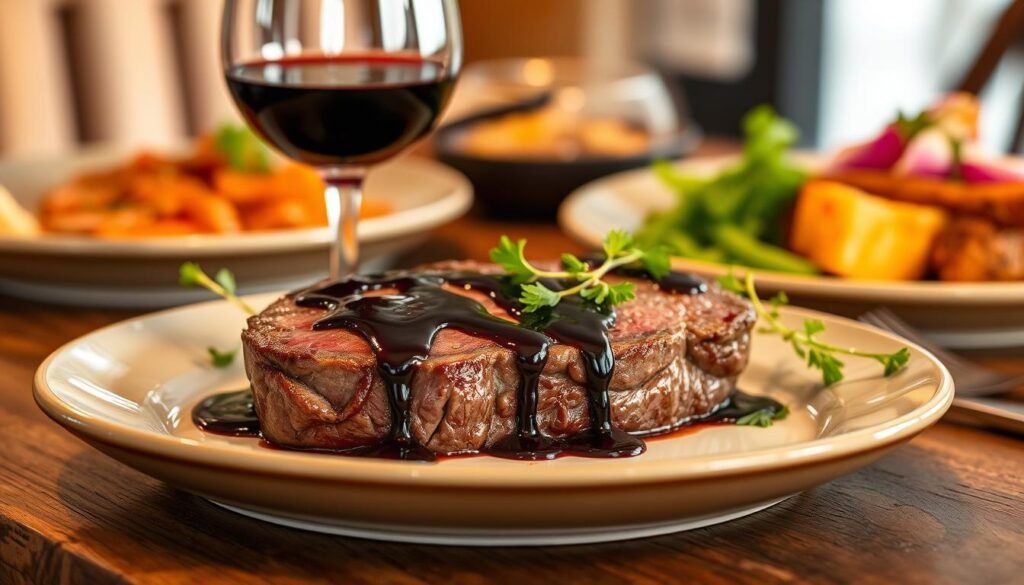
Choosing the perfect wine for your balsamic-glazed filet mignon is key. It’s about finding the right balance between the meat’s rich taste and the wine’s complex flavors.
Red Wine Recommendations
Here are our top red wine picks:
- Cabernet Sauvignon: A strong wine with dark fruit notes that match the steak’s richness
- Merlot: A milder choice with fruity hints that make the filet tender
- Zinfandel: A bold wine that can handle the balsamic glaze’s boldness
Alternative Beverage Pairings
Not into red wine? No problem! Try these instead:
- Full-bodied Chardonnay for a white wine choice
- Sparkling water with lemon for a bubbly, alcohol-free drink
- Craft cocktails that match the steak’s rich taste
Tip for those who love fine dining: The goal is to find a wine that boosts your dish, not hides it. Experiment and listen to your taste buds!
Troubleshooting Common Cooking Issues
Cooking the perfect beef tenderloin can be tricky, even for experienced home chefs. Let’s dive into some common challenges you might encounter when preparing your steak and how to overcome them.
Texture and Doneness Challenges
Steak turning out tough? This often happens when the beef tenderloin is overcooked. Remember, lean cuts like filet mignon can quickly become dry and chewy. Here are some quick fixes:
- Reduce cooking time by 1-2 minutes
- Use a meat thermometer to check internal temperature
- Remove steak from heat slightly before desired doneness
Crust and Seasoning Problems
Struggling with a pale, lackluster steak? The key is in the preparation and seasoning. Check these potential issues:
- Ensure pan is smoking hot before adding steak
- Pat meat dry before seasoning
- Use generous amounts of salt and pepper
Balsamic Glaze Troubleshooting
Your balsamic glaze can make or break the steak’s flavor. Here’s how to perfect it:
| Issue | Solution |
|---|---|
| Glaze too thin | Simmer longer to reduce and thicken |
| Glaze too thick | Add a splash of wine or water |
| Bland flavor | Add a pinch of sugar or extra balsamic vinegar |
Cooking is a journey of learning and adaptation. Each time you prepare a steak, you’ll gain more confidence and skill. Don’t be discouraged by small mishaps – they’re part of becoming a better cook!
Conclusion
Cooking filet mignon is more than a recipe; it’s a journey that turns home cooking into a gourmet experience. We’ve covered every detail to help you make a steak as good as a restaurant’s. From choosing top USDA Prime beef to knowing the exact cooking temperatures, each step is key to making the perfect filet mignon.
The path to a great steak starts with quality ingredients and careful prep. A 6-8 ounce filet mignon, about 1.5 inches thick, can become a masterpiece with the right skills. It’s all about knowing the right temperatures, timing, and techniques to make your cooking stand out.
Whether it’s for a romantic dinner or to wow your guests, these tips will make your filet mignon tender, tasty, and perfectly cooked. Dive into the process, trust your instincts, and savor the delicious outcome of your new cooking skills.
